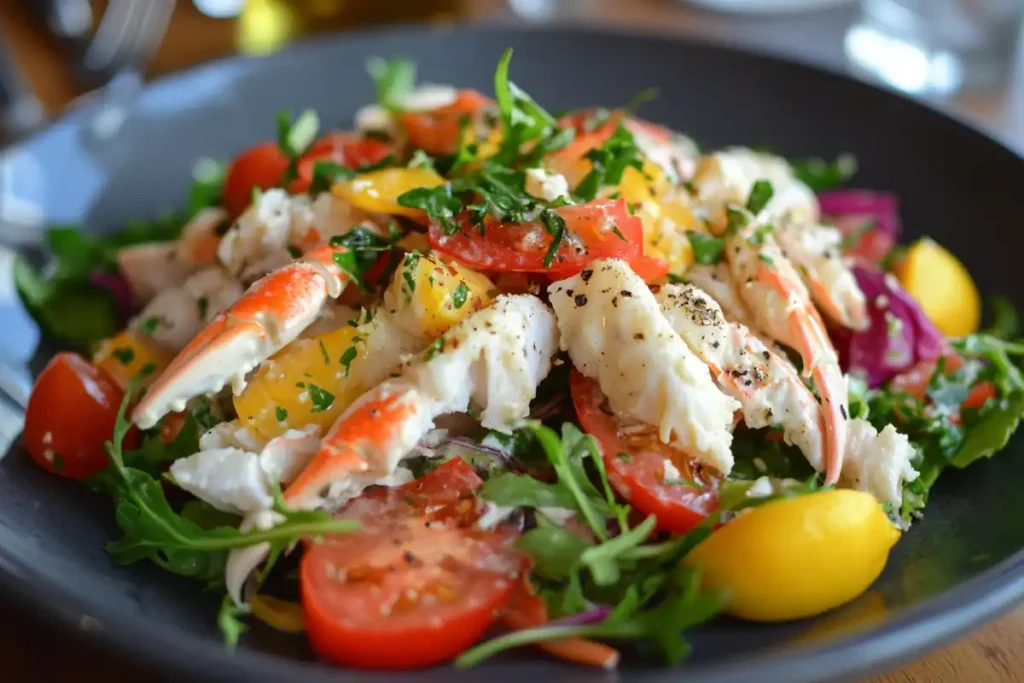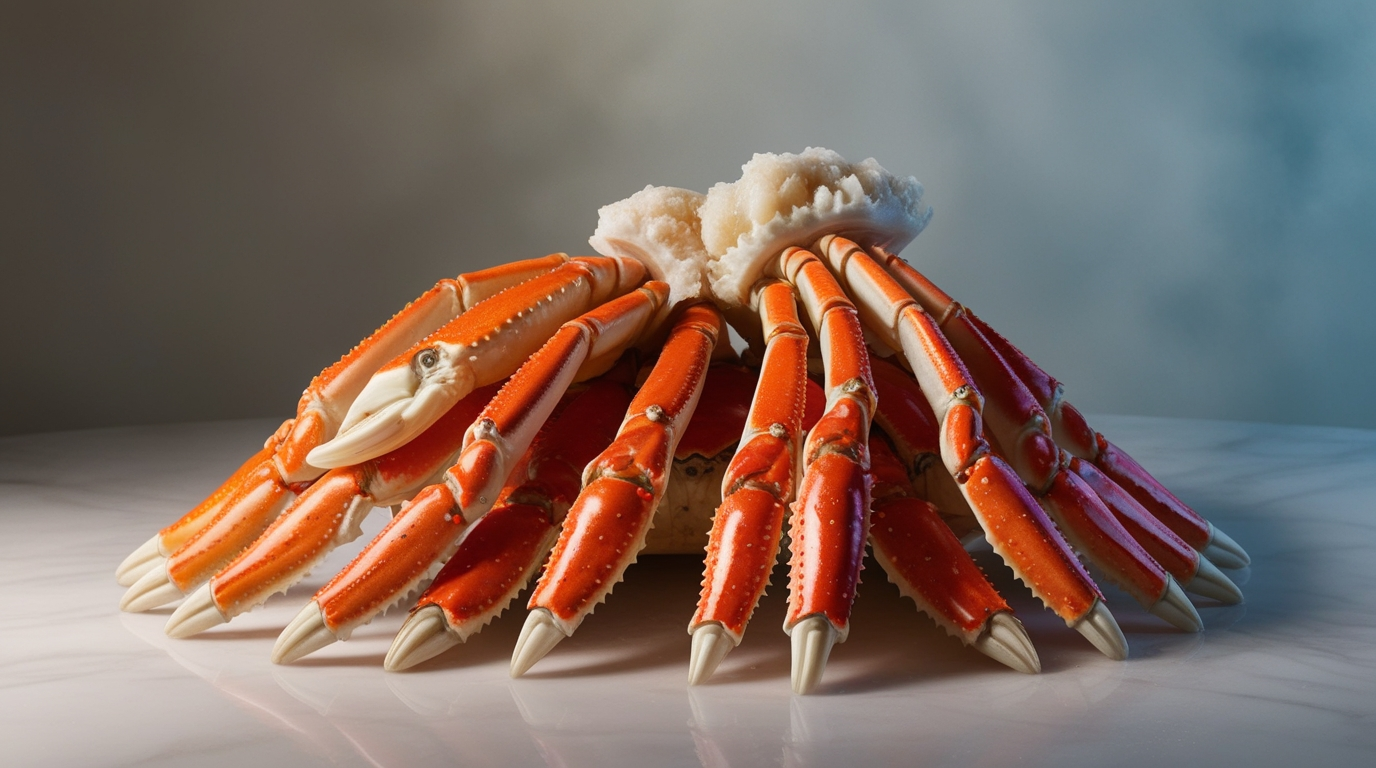Table of Contents
How Many Snow Crab Legs Are in 1 Pound?

Snow crab legs delight seafood lovers with their sweet flavor and delicate texture. How many legs is 1 lb of snow crab legs? This common question arises as home cooks attempt to plan meals, portion servings, and ensure everyone enjoys a satisfying feast. In this comprehensive guide, we will explore the intricacies of counting snow crab legs per pound, consider factors that influence these counts, and offer tips on cooking, selecting, and serving them. Furthermore, we will discuss cost, nutrition, and alternate crab varieties, ensuring you gain a solid understanding of this delicious crustacean. Ultimately, by the end of this article, you will feel confident in estimating leg counts, preparing them perfectly, and getting the best value for your purchase.
Understanding Snow Crab Legs
Snow crabs thrive in cold northern oceans, chiefly in the Atlantic and Pacific waters. They feature long, slender legs that yield delicate, sweet-tasting meat. Comparatively smaller than king crabs, snow crabs still provide an excellent source of lean protein, vitamins, and minerals. Essentially, snow crab legs often come in clusters, each containing multiple legs and a claw arm. Because many sellers package snow crab legs in pre-portioned groups, it becomes simpler to understand how many legs is 1 lb of snow crab legs? Indeed, understanding the nature of the product helps set the groundwork for counting and estimating portions.
These crabs are not only tasty but also versatile. You can steam or boil them to preserve their mild sweetness. Meanwhile, their meat easily shreds, making it perfect for salads, crab cakes, and pasta dishes. Especially when served warm with melted butter and lemon, snow crab legs offer an unforgettable dining experience.
Counting Snow Crab Legs per Pound: How many legs is 1 lb of snow crab legs?

When determining how many legs is 1 lb of snow crab legs? there is no single, universally perfect number. Generally, a pound of snow crab legs often includes about 8 to 10 legs. However, this number may fluctuate depending on the specific size and variety of the crab. While many sellers package them in clusters, a single pound might include one large cluster plus a smaller piece, or two medium clusters totaling about 8 legs. Consequently, it is wise to remember that leg counts vary, though 8 to 10 legs per pound is a commonly accepted guideline.
How many legs is 1 lb of snow crab legs? Factors
Various factors influence the number of legs per pound. For example, larger crab species with thicker shells might mean fewer legs per pound. Conversely, smaller specimens yield more legs per the same weight. Additionally, shell thickness and moisture content affect the total weight. Buyers should rely on trusted suppliers who are transparent about leg sizes and cluster packaging. Altogether, when asking how many legs is 1 lb of snow crab legs? consider these nuances.
How many legs is 1 lb of snow crab legs? Typical Estimates
Typically, a pound of snow crab legs comes from about two clusters. Each cluster often includes four legs and a claw arm. Since cluster sizes vary, you might receive around 8 legs per pound. Comparatively, some market selections might offer slightly fewer legs if they are particularly large. Nonetheless, counting on approximately 8 to 10 legs per pound provides a reasonable baseline.
How many legs is 1 lb of snow crab legs? Cooking Implications
When it comes to cooking, knowing how many legs is 1 lb of snow crab legs? can help you plan serving sizes. For instance, if you expect each guest to consume about a half-pound portion, understanding leg counts ensures you can distribute equal shares. While the precise number may differ slightly, a good rule of thumb helps ensure everyone enjoys a fair and satisfying taste of these delectable legs.
Factors Affecting Leg Count
Primarily, crab size affects how many legs per pound you receive. Larger, meatier legs weigh more, so you get fewer pieces per pound. Meanwhile, smaller or younger crabs yield more legs by count. Additionally, how the legs are processed and packaged plays a role. Some suppliers remove excess shell or segment the legs differently, altering total counts. Another key factor involves where you shop, as different regions may offer varying cluster sizes or crab species.
Measuring Serving Sizes: How many legs is 1 lb of snow crab legs?
Determining serving sizes depends on personal appetite, menu variety, and the presence of side dishes. Nevertheless, using the guideline of how many legs is 1 lb of snow crab legs? helps. Suppose you serve a main course of crab legs with simple sides. In that case, about 1 pound per person often suffices. If you serve crab as part of a seafood feast, half a pound per person may be enough. Basically, consider other dishes offered. If you serve buttery rolls, hearty salads, or pasta, you might reduce the number of legs needed. Comparatively, if crab legs are the centerpiece, ensure each guest receives a generous portion.
In general, if hosting a large gathering, calculate the total number of legs needed by multiplying per-person estimates. Eventually, adjust these calculations based on actual leg counts upon purchase.
Cooking and Preparation Tips
There are several ways to prepare snow crab legs. Chiefly, steaming or boiling are popular methods that preserve sweetness and moisture. Afterward, you can serve them hot with melted butter, lemon wedges, or simple dipping sauces. Another approach involves grilling or broiling, imparting a smoky, savory flavor. Furthermore, consider seasoning them lightly with herbs, garlic, or spices for a custom taste profile.
Because the shells are relatively thin, snow crab legs are easy to crack using a crab cracker or kitchen shears. In addition, serve them with napkins and a small fork to help guests easily extract the meat. Ultimately, simple preparation often highlights their natural flavor, ensuring a delightful seafood experience.
Tips for Buying Snow Crab Legs
When shopping, look for legs with a bright, consistent color and no off odors. Because crab legs are often pre-cooked and flash-frozen at sea, freshness is determined by how well they were handled after harvest. Thus, buying from reputable suppliers helps ensure quality. Moreover, check the shell for signs of freezer burn, dryness, or discoloration. Eventually, consider purchasing from a trusted fishmonger or high-quality supermarket. While fresh legs might be available in coastal regions, frozen legs are widely accessible and often taste just as delicious.
Nutrition and Dietary Considerations
Snow crab legs provide lean protein, essential minerals, and beneficial nutrients. They contain good amounts of vitamin B12 and minerals like zinc and selenium. Meanwhile, they are comparatively low in saturated fat. Consequently, they fit well into a balanced diet, especially when prepared with minimal added fats. However, individuals with shellfish allergies or dietary restrictions must exercise caution. Generally, moderate consumption aligns well with healthful eating patterns.
Cost and Value: How many legs is 1 lb of snow crab legs?
When assessing value, considering how many legs is 1 lb of snow crab legs? proves helpful. Typically, prices vary by season, region, and availability. Larger crab legs might cost more due to their size and meatiness. Nevertheless, understanding leg counts per pound helps gauge cost-effectiveness. If you pay more for fewer, thicker legs, compare the total meat yield. Conversely, more legs might mean thinner shells but greater ease in portioning. Balancing quality, freshness, and price ensures you get the best deal. Eventually, shop around and explore different suppliers to find your ideal balance of cost and value.
Storage and Handling
Store snow crab legs properly to preserve flavor and texture. Initially, keep frozen legs in your freezer until ready to thaw. Subsequently, transfer them to the refrigerator overnight for slow, safe thawing. Afterward, cook them promptly and avoid refreezing. If you have leftovers, store cooked meat in airtight containers and consume within a couple of days. Moreover, never leave crab legs at room temperature for extended periods, as this encourages bacterial growth. In short, proper handling ensures food safety and maintains premium taste.
Alternative Crab Varieties
While snow crab legs are delightful, consider exploring other crab options. King crab legs are larger, meatier, and come at a higher price point. Dungeness crab offers a sweeter, delicate flavor. However, their body sections contain more meat than the legs. Generally, if you enjoy snow crab, experimenting with other varieties broadens your culinary horizons. Comparatively, different crab species suit different recipes. For example, king crab might be perfect for a luxurious dinner, while Dungeness crab fits beautifully into a bisque or a seafood stew.
Common Mistakes to Avoid
Many home cooks overcook crab legs, resulting in dry, rubbery meat. To prevent this, keep cooking times short since crab legs are pre-cooked before freezing. Another common error is under-seasoning. Although the natural sweetness of the meat shines, a light sprinkle of herbs, a squeeze of lemon, or a dab of melted butter can elevate the dish. Meanwhile, be cautious when buying discounted legs, as extremely low prices might signal older or lower-quality product. By avoiding these mistakes, you ensure a consistently enjoyable seafood experience.
Enjoying Snow Crab in Different Dishes
Snow crab meat’s delicate flavor and texture shine in various culinary creations. Add shredded crab meat to creamy chowders or bisques for a touch of luxury. Additionally, toss chunks of crab into salads with crisp lettuce, avocado, and a light vinaigrette. Another approach involves folding crab meat into pasta with garlic butter, cherry tomatoes, and fresh herbs. Comparatively, rolling crab into sushi, topping off a seafood flatbread, or layering it into a crab roll sandwich offers unique ways to enjoy it. Undoubtedly, the versatility of snow crab legs ensures you never run out of delicious options.
Conclusion: How many legs is 1 lb of snow crab legs?
In conclusion, understanding how many legs is 1 lb of snow crab legs? helps you plan meals, estimate servings, and shop confidently. While the number typically hovers around 8 to 10 legs per pound, factors like crab size, packaging, and cooking methods play a significant role. By considering these details, you ensure that each dining experience feels delightful and balanced. Enjoy exploring various cooking techniques, experimenting with side dishes, and even sampling other crab varieties. Above all, treat snow crab legs as a versatile, nutritious, and tasty addition to your culinary repertoire. With the right knowledge, you can savor every bite.
FAQ Section
How many snow crab legs are in 1 pound?
Typically, about 8 to 10 legs come in 1 pound of snow crab legs. However, variations occur due to leg size and crab species. Smaller legs result in more pieces per pound, while larger legs mean fewer pieces.
How much does 1lb of crab legs feed?
Usually, 1 pound of crab legs can feed one person as a main course, especially if served with sides. If part of a larger seafood feast, 1 pound can feed two people as a smaller portion.
How many crabs do you get for 1 lb?
It depends on the size of the crab and how the legs are packaged. Often, 1 pound of legs might come from one or two clusters of a single crab. Each cluster typically includes four legs and a claw arm.
Is a pound of snow crab enough for 2 people?
A pound can be enough for two people if you serve crab legs as an appetizer or alongside multiple side dishes. However, if crab legs are the star attraction, you might want slightly more than 1 pound to ensure everyone feels satisfied.

